Architecture Home Styles
10 Key Differences Between English and French Tudor Style
Uncover the intricate nuances that set apart English and French Tudor styles, delving into the fascinating world of architectural contrasts waiting to be revealed.
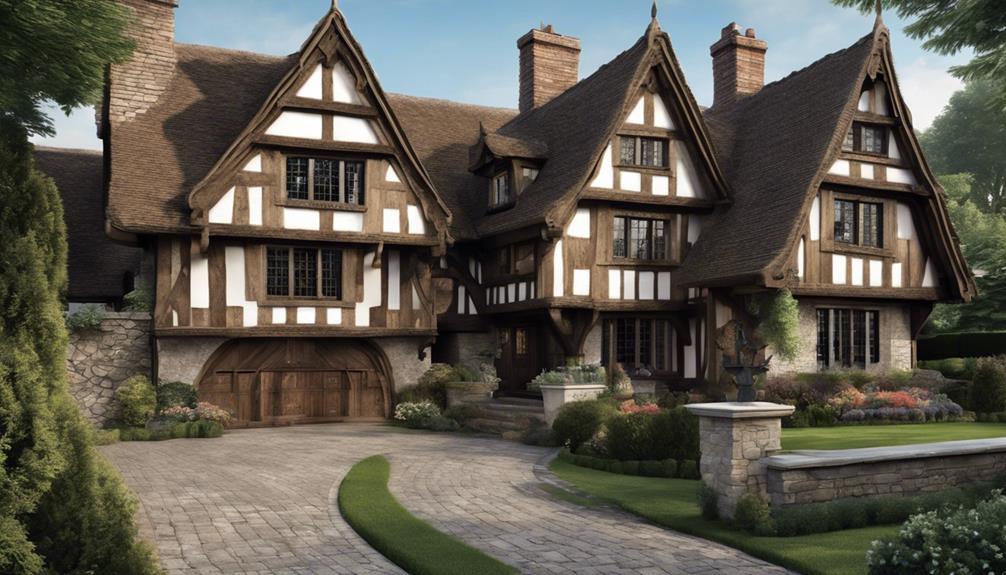
Let's explore the subtle yet significant nuances that distinguish English and French Tudor architectural styles, offering a glimpse into the intricate details that define each.
As we compare these two captivating design aesthetics, we uncover a world of contrasting elements that shape the essence of these historical structures.
From the materials used to the overall aesthetic appeal, each aspect holds a tale of cultural heritage and architectural evolution waiting to be uncovered.
Key Takeaways
- English Tudor houses emphasize half-timbering and wooden beams, while French Tudor houses focus on intricate masonry work.
- English Tudor roofs have steep pitches with decorative half-timbering gables, while French Tudor roofs feature shallower pitches and dormer windows.
- English Tudor windows are asymmetrical with leaded glass, whereas French Tudor windows are symmetrical with elaborate metalwork designs.
- English Tudor style uses warm colors and wood ornamentation, contrasting French Tudor's muted palette and metalwork emphasis.
Materials and Construction Techniques
When comparing English and French Tudor styles in terms of materials and construction techniques, the distinct differences become evident through the contrasting use of timber framing and intricate masonry work, respectively.
English Tudor houses often showcase half-timbering, where the wooden framework is exposed, creating a charming and traditional aesthetic. The use of decorative wooden beams in half-timbering adds a sense of character and warmth to the structures.
On the other hand, French Tudor houses tend to emphasize intricate masonry work, incorporating detailed stone and brick elements that contribute to a more refined and elaborate appearance. The sculptural details in French Tudor homes reflect a dedication to craftsmanship and artistic flair not typically seen in English Tudor architecture.
These contrasting approaches to materials and construction techniques highlight the unique cultural influences and design preferences that distinguish English and French Tudor styles, offering a rich tapestry of architectural innovation for enthusiasts to explore.
Roof Styles and Pitches

The distinction between English and French Tudor roof styles lies in their varying pitches and intricate design elements that significantly impact the overall architectural aesthetics of these homes. When comparing the roof styles and pitches of English and French Tudor homes, several key differences emerge:
- English Tudor roofs feature steep pitches of at least 13:12, emphasizing a more pronounced and towering appearance.
- French Tudor roofs, on the other hand, may have shallower pitches, contributing to a more subtle and refined look.
- French Tudor roofs often incorporate dormer windows and intricate detailing, adding a sense of elegance and complexity not typically seen in English Tudor roofs.
- English Tudor roofs commonly exhibit gable ends with decorative half-timbering, while French Tudor roofs may showcase more elaborate design elements, enhancing their overall grandeur.
- French Tudor roof styles may include hipped roofs with multiple slopes, introducing a unique architectural feature that sets them apart from the more traditional English Tudor roofs.
Window Designs and Placement
Comparing English and French Tudor window designs and placement reveals distinctive characteristics that contribute to the overall charm and elegance of these architectural styles. In English Tudor homes, casement windows with small panes and leaded glass are common, adding a historic and cozy feel. Conversely, French Tudor homes may feature larger windows with intricate metalwork designs, offering a touch of sophistication. Window placement in English Tudor houses tends to be asymmetrical, enhancing uniqueness, while French Tudor houses often opt for balanced and symmetrical arrangements. English Tudor homes typically frame windows with wood or metal for a traditional look, whereas French Tudor homes may use elaborate stone surrounds for added elegance. Leaded glass is prevalent in English Tudor architecture, while French Tudor homes may showcase stained glass windows for a more decorative touch. English Tudor houses often have multiple window groupings, creating visual interest, while French Tudor houses may focus on larger, grand windows for an open and airy ambiance.
| English Tudor | French Tudor |
|---|---|
| Casement windows with small panes and leaded glass | Larger windows with intricate metalwork designs |
| Asymmetrical window placement | Balanced and symmetrical window arrangements |
| Windows framed with wood or metal | Elaborate stone surrounds for added elegance |
Decorative Elements and Ornamentation
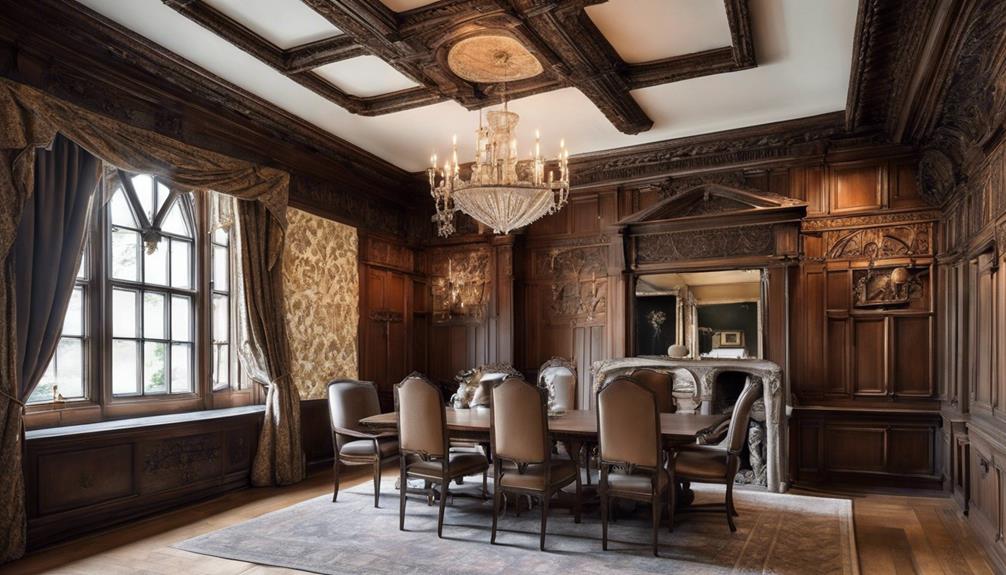
When comparing English and French Tudor styles, we notice distinct differences in the decorative elements and ornamentation used. English Tudor houses often showcase carved wood details in intricate designs, highlighting the craftsmanship of the era.
Conversely, French Tudor architecture leans towards more elaborate metalwork designs, adding a touch of elegance and sophistication to the overall aesthetic.
The contrasting emphasis on wood and metalwork in these styles reflects the unique cultural influences and artistic preferences of each tradition.
Carved Wood Details
In English Tudor style, carved wood details exhibit intricate geometric patterns and floral motifs, while French Tudor style embraces more delicate and ornate carvings with intricate scrollwork and vine designs. English Tudor houses may showcase exposed oak beams with simple geometric carvings for a rustic charm, whereas French Tudor homes typically display more refined and elegant wood carvings, such as elaborate rosettes and sculptural elements.
The wood detailing in English Tudor style tends to be more understated and functional, emphasizing practicality. In contrast, French Tudor style places a strong emphasis on decorative artistry and craftsmanship, creating a more ornate and intricate aesthetic. The differences in wood carvings between these two styles highlight the unique design sensibilities of each.
- English Tudor: Simple geometric carvings on exposed oak beams
- French Tudor: Elaborate rosettes and sculptural elements
- English Tudor: Understated and functional wood detailing
- French Tudor: Emphasis on decorative artistry and craftsmanship
- English Tudor: Intricate geometric patterns and floral motifs
Intricate Metalwork Designs
Drawing on the intricate wood carvings discussed in the previous subtopic, the focus now shifts to exploring the elaborate metalwork designs that distinguish English and French Tudor styles in their decorative elements and ornamentation. In French Tudor homes, intricate wrought iron designs grace gates, railings, and balconies, exuding sophistication and elegance. On the other hand, English Tudor houses showcase detailed metalwork in door hardware, window grilles, and light fixtures, adding charm and character. French Tudor style emphasizes ornate metalwork on lanterns, brackets, and decorative accents, enhancing the overall aesthetic, while English Tudor houses often display craftsmanship and attention to detail in hand-forged hinges, latches, and hardware. The metalwork in French Tudor style appears more elaborate and decorative compared to the equally intricate metalwork in English Tudor homes.
| French Tudor Style | English Tudor Style |
|---|---|
| Intricate wrought iron designs | Detailed metalwork in door hardware |
| Sophisticated and elegant look | Adds charm and character |
| Ornate metalwork on exterior features | Showcases craftsmanship and attention to detail |
| Emphasizes decorative accents | Reflects simplicity with intricate designs |
| Elaborate and decorative approach | Equally intricate but simpler approach |
Color Palette and Finishes
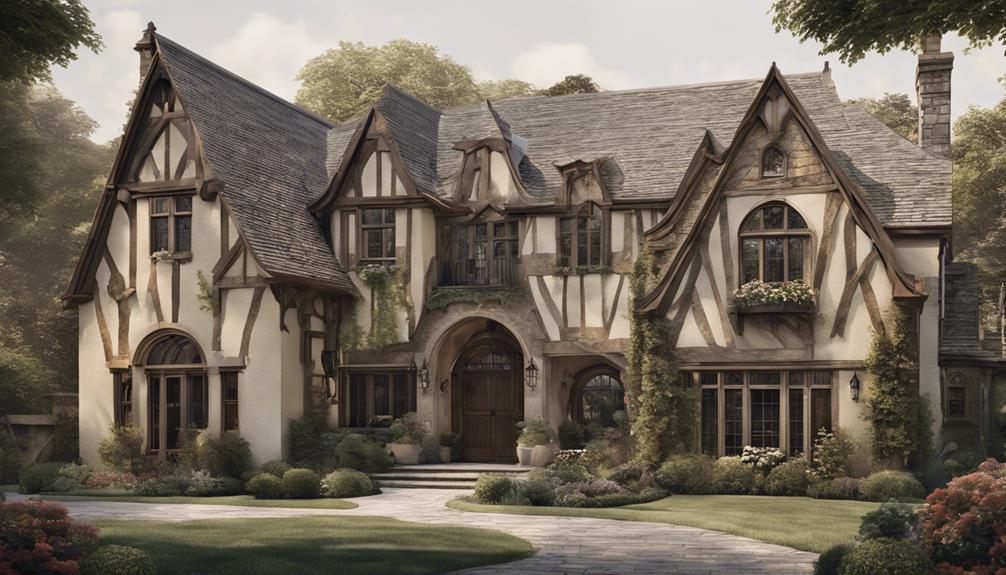
Exploring the color palette and finishes of English and French Tudor styles reveals distinct design choices that reflect their cultural influences and historical backgrounds.
In English Tudor houses, warm colors like crimson, yellow, gold, and orange dominate the interior, creating a cozy and inviting atmosphere. On the contrary, French Tudor homes lean towards a more muted palette with shades of gray, beige, and soft pastels, exuding a subtle and elegant look.
The choice of finishes also sets these styles apart. English Tudor homes often feature darkly stained or white-painted wood for their interior finishes, evoking richness and tradition. In contrast, French Tudor houses may opt for lighter wood finishes or painted wood in soft tones to achieve a refined and airy ambiance.
These design elements not only differentiate the two styles but also offer insight into the historical and cultural influences that shaped their unique aesthetics.
- English Tudor: Warm colors like crimson, yellow, gold, and orange
- French Tudor: Muted palette with shades of gray, beige, and soft pastels
- English Tudor: Darkly stained or white-painted wood finishes
- French Tudor: Lighter wood finishes or painted wood in soft tones
- Reflect cultural and historical influences
Interior Layout and Features
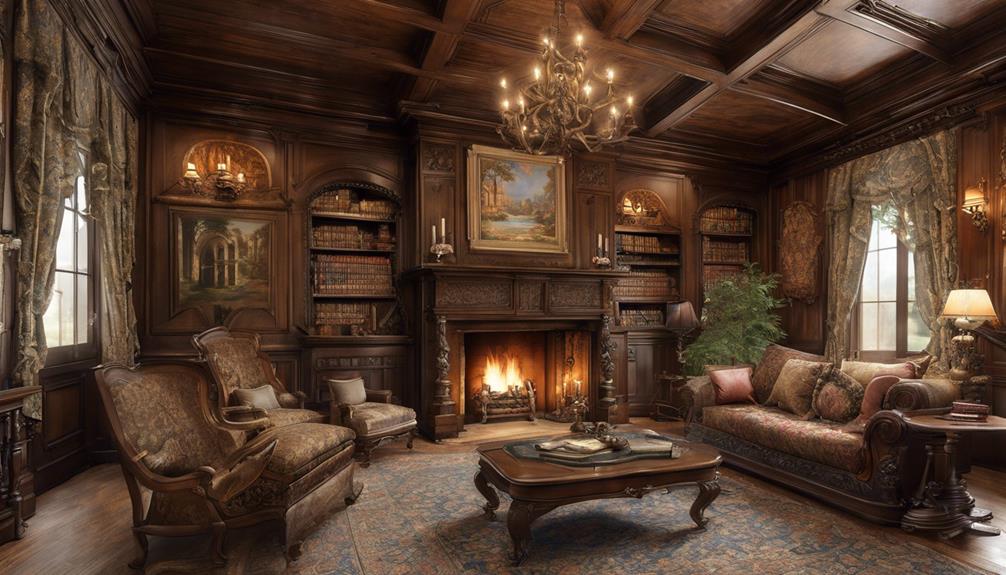
When comparing English and French Tudor interiors, we can observe distinct differences in room sizes and shapes, furniture placement, and decorative elements.
English Tudor homes often feature cozy, smaller rooms with a focus on functionality and warmth, while French Tudor houses tend to incorporate grander, more spacious rooms designed for elegance and sophistication.
Additionally, furniture placement in English Tudor interiors is centered around practicality and comfort, whereas French Tudor interiors showcase furniture arrangement that highlights luxury and refined taste.
Room Sizes and Shapes
In comparing the room sizes and shapes of English and French Tudor styles, one can observe distinct differences in spatial design and decorative elements that reflect contrasting design philosophies.
- English Tudor interiors often feature larger, more spacious rooms that prioritize comfort and functionality in the layout.
- French Tudor homes tend to have smaller, more intimate rooms with intricate detailing and ornate features.
- English Tudor houses may incorporate open floor plans, creating a seamless flow between rooms and an airy atmosphere.
- French Tudor residences commonly showcase curved walls, elaborate moldings, and decorative ceiling treatments for a luxurious feel.
- English Tudor designs emphasize practicality and usability in room sizes and shapes, while French Tudor aesthetics prioritize opulence and grandeur.
Furniture Placement
Furniture placement in English and French Tudor styles distinguishes itself through the choice of heavy, dark wood pieces in English interiors and lighter, ornate furniture in French settings, reflecting contrasting design preferences. English Tudor homes often feature functional layouts with sturdy oak furniture, creating a cozy and traditional atmosphere. In contrast, French Tudor interiors showcase elegance with furniture pieces boasting intricate curves, painted finishes, and decorative accents. To highlight the differences further, let's examine a comparative table:
| Aspect | English Tudor Style | French Tudor Style |
|---|---|---|
| Furniture | Heavy, dark wood with intricate details | Lighter, ornate with delicate designs |
| Layout | Functional and practical | Refined and luxurious |
| Atmosphere | Cozy and traditional | Elegant and sophisticated |
This table visually captures the essence of furniture placement in the distinct Tudor styles, offering insight into their unique characteristics.
Decorative Elements
Exploring the decorative elements of English and French Tudor styles reveals distinctive color palettes, materials, and ornamental details that characterize their interior layouts and features.
In English Tudor architecture, warm colors like crimson, yellow, and gold dominate the interior design, while French Tudor style often opts for lighter, pastel hues and intricate tapestries. English Tudor houses typically showcase darkly stained or white-painted wood for a traditional aesthetic, contrasting with the more ornate moldings, carvings, and metalwork found in French Tudor homes.
Additionally, hardwood floors are a common feature in English Tudor houses, whereas French Tudor residences may incorporate more tiled surfaces in their living areas. These nuanced differences in decorative elements contribute to the unique charm of each Tudor style.
Chimney Designs and Placement
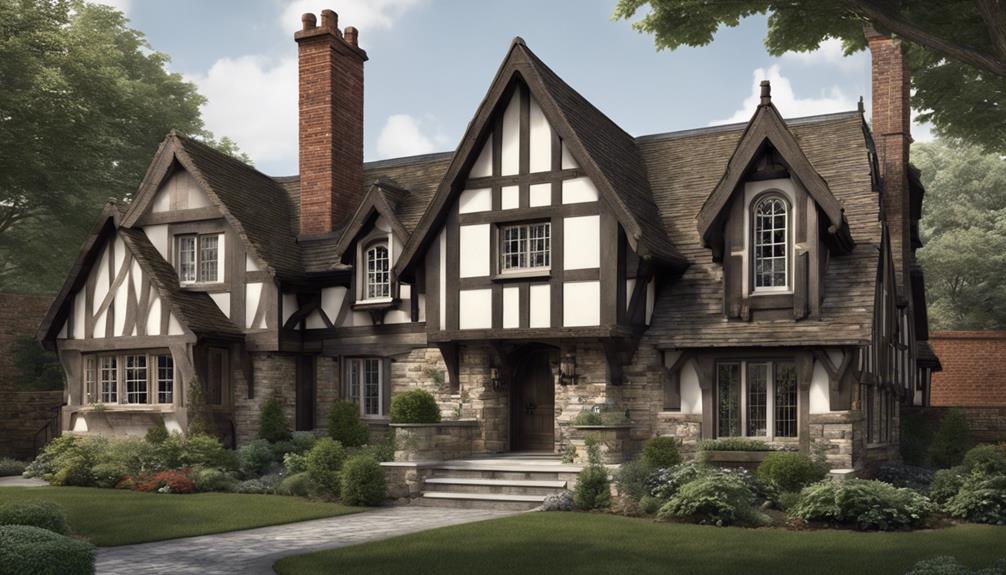
Amidst the architectural distinctions between English and French Tudor styles, the design and placement of chimneys serve as pivotal elements that delineate the unique character and aesthetic of each.
In French Tudor houses, chimneys often boast intricate designs influenced by French architecture, adding a touch of elegance and sophistication. These chimneys are strategically placed asymmetrically to create visual intrigue and individuality, embodying the artistic flair of French design.
On the other hand, English Tudor homes feature prominent chimneys with decorative chimney pots that contribute to their traditional and historic charm. These chimneys are carefully positioned to maintain the overall symmetry of the architecture, enhancing the classic appeal of English Tudor style.
While both styles prioritize the functionality of chimneys, the French Tudor houses lean towards artistic expression and asymmetry, whereas English Tudor homes focus on symmetry and historical significance. The design and placement of chimneys play a significant role in shaping the overall aesthetic and allure of English and French Tudor properties.
Garden and Landscape Integration
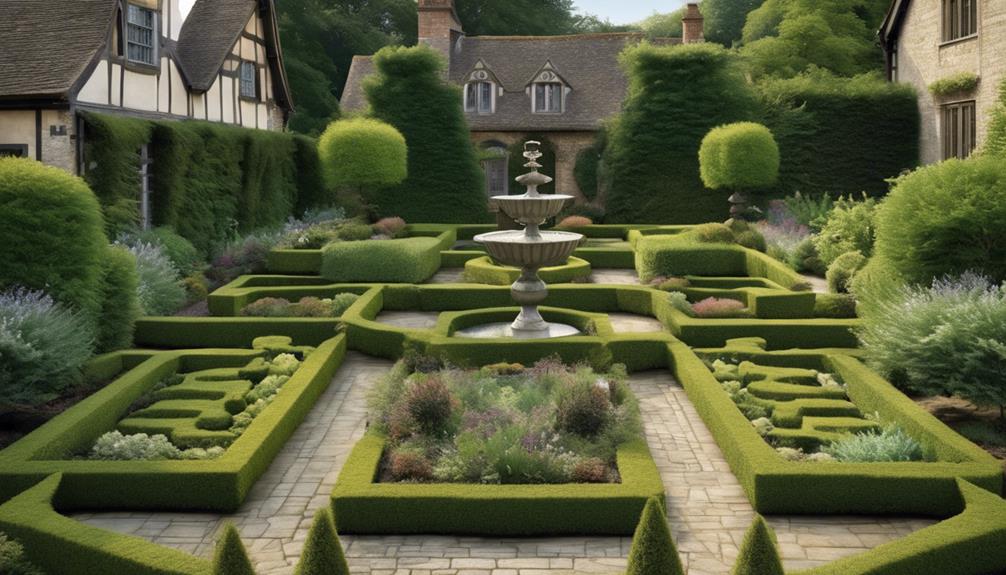
Integrating garden landscapes within English and French Tudor architecture involves a meticulous blend of formal structure and natural elements, reflecting distinct cultural influences and design philosophies. When comparing the garden and landscape integration in these two styles, several key differences emerge:
- Symmetry vs. Haphazard Layouts: English Tudor gardens often boast formal designs with symmetrical layouts, while French Tudor gardens may embrace a more haphazard look with a mix of fruits, vegetables, and plants.
- Fencing Styles: French Tudor houses tend to feature ornate wrought iron fencing with brick columns in the garden, whereas English Tudor houses typically opt for more traditional fencing styles.
- Walking Paths: Both English and French Tudor gardens commonly incorporate gravel walking paths, adding a rustic and charming touch to the outdoor space.
- Architectural Elements: English Tudor gardens may include grandiose features like pools and statues, while French Tudor gardens focus on natural elements and a relaxed ambiance.
- Owner Influence: The design of Tudor gardens in both styles is heavily influenced by the owner's preferences, economic status, and the size of the property.
Regional Influences and Variations

Comparing English Tudor and French Tudor style homes reveals distinct architectural features influenced by regional design traditions and historical contexts. In English Tudor homes, leaded glass windows are a common feature, adding a touch of charm and character to the façade. These windows often contribute to the cozy and traditional interior ambiance of English Tudor houses.
On the other hand, French Tudor homes tend to have larger windows that allow more natural light to enter the living spaces, creating a bright and airy atmosphere within the home.
When it comes to color schemes, English Tudor homes typically embrace warm, earthy tones such as browns, greens, and reds, reflecting the natural elements of the surrounding landscape. In contrast, French Tudor homes may incorporate a more diverse color palette, drawing inspiration from the elegant and sophisticated hues often seen in French interior design.
These variations in window styles and color schemes between English and French Tudor homes showcase how regional influences play a significant role in shaping the distinctive characteristics of each architectural style.
Overall Aesthetic and Character
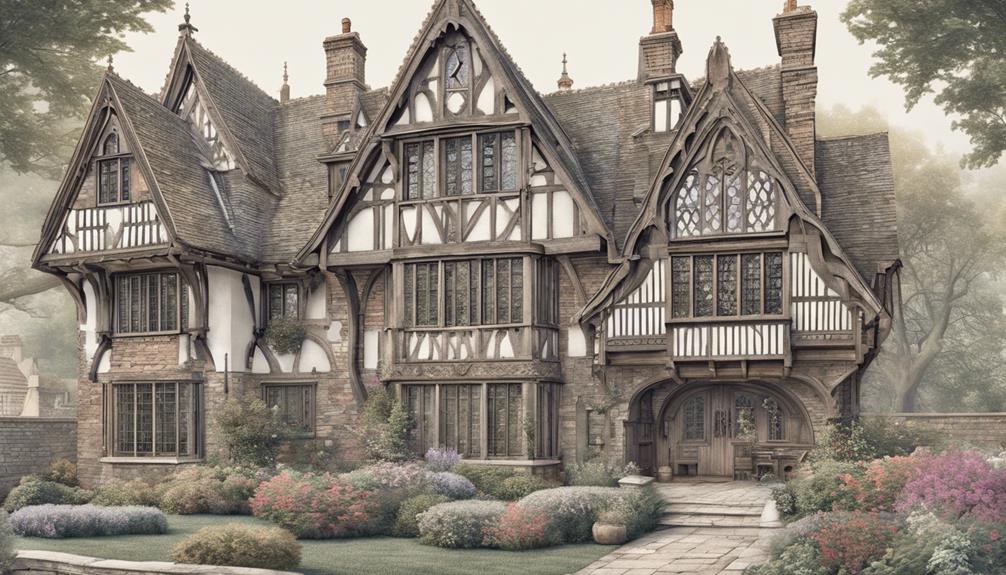
When comparing the overall aesthetic and character of English and French Tudor style homes, it becomes clear that the design elements and color palettes play a significant role in distinguishing between the two.
English Tudor homes showcase a more eclectic mix of decorative half-timbering, leaded glass windows, and prominent chimneys, creating a cozy, rustic charm.
In contrast, French Tudor houses boast refined stonework, intricate carvings, and elegant rooflines, exuding sophistication and grace with a touch of grandeur.
The distinct choices in design elements and color palettes between English and French Tudor styles contribute to their unique visual appeal and character.
Design Elements
In exploring the design elements of English and French Tudor styles, the distinct aesthetic and character differences become apparent through their emphasis on asymmetry and eclectic exteriors versus symmetry and classical architectural elements, respectively.
- English Tudor houses often feature doors and windows with irregular shapes and sizes, adding to the charm of the asymmetrical design.
- Dark wood plays a significant role in English Tudor interiors, creating a cozy and inviting atmosphere.
French Tudor exteriors tend to showcase more balanced and symmetrical arrangements of doors and windows for a classical look.
- Ornate stonework and brickwork are common in French Tudor houses, enhancing the elegance of the overall design.
- While English Tudor interiors lean towards warm colors and dark wood, French Tudor interiors may opt for a lighter color palette with sophisticated decorative elements.
Color Palette
While English Tudor houses embrace a warmer color palette to evoke a cozy and inviting ambiance, French Tudor style opts for cooler tones to exude elegance and sophistication in their overall aesthetic and character.
English Tudor homes often feature rich shades like crimson, yellow, gold, and orange, creating a traditional and rustic charm that connects with nature.
In contrast, French Tudor houses lean towards cooler tones such as blues, grays, and whites, giving off a more refined and formal appearance that conveys luxury.
The choice of colors in these styles plays a significant role in setting the tone and atmosphere of the homes, with English Tudor emphasizing warmth and comfort while French Tudor focuses on elegance and sophistication, ultimately shaping the overall aesthetic and character of each architectural style.
Frequently Asked Questions
What Is the Difference Between English Tudor and French Tudor?
When comparing English Tudor with French Tudor architecture, we notice distinct differences. English Tudor homes typically showcase half-timbering and decorative brick or stone exteriors, while French Tudor properties feature more intricate stonework and ornate detailing.
English Tudor houses tend to have steeply pitched roofs and decorative chimney stacks, whereas French Tudor homes boast elaborate rooflines and unique masonry chimney work. These variations in architectural elements set the two styles apart.
What Is the Tudor-Style in England?
When it comes to Tudor-style architecture in England, we find a unique blend of medieval and Renaissance influences. This style showcases decorative half-timbering, steep roofs, intricate brickwork, and distinctive chimneys, all contributing to its picturesque and traditional look.
Asymmetrical designs, cross gables, and leaded glass windows are common features, reflecting a rich historical and cultural background. This architectural style holds a deep connection to English heritage, with elements like exposed wood beams and stone fireplaces adding to its charm.
What Are the Distinctive Features of Tudor Houses?
When considering the distinctive features of Tudor houses, one can't overlook the steeply pitched gable roofs, decorative half-timbering, and elaborate masonry chimneys. These elements, along with embellished doorways, unique window groupings, and intricate brickwork patterns, collectively contribute to the iconic look of Tudor architecture.
With a rich historical background blending English and Medieval traditions, Tudor houses stand out for their blend of French and German influences, creating a picturesque and traditional appearance.
Is Tudor an English Style?
Yes, Tudor style architecture is undeniably English in origin, with its roots deeply embedded in the Tudor period of England. Its distinctive features, such as half-timbered exteriors and steep roofs, reflect a unique blend of medieval and Renaissance influences.
While other styles may have influenced Tudor architecture, its essence remains quintessentially English. This style beautifully showcases England's rich historical and cultural background, making it a symbol of English architectural tradition.
Conclusion
In conclusion, the English and French Tudor styles may have their differences, but at the end of the day, both showcase a timeless charm and elegance that can transport you to a bygone era.
So whether you prefer the cozy half-timbered cottages of England or the ornate gardens of France, one thing is for sure – Tudor architecture will always have a special place in our hearts (and maybe even our dream home Pinterest boards).
Cheers to the enduring allure of Tudor style!
- About the Author
- Latest Posts
Introducing Ron, the home decor aficionado at ByRetreat, whose passion for creating beautiful and inviting spaces is at the heart of his work. With his deep knowledge of home decor and his innate sense of style, Ron brings a wealth of expertise and a keen eye for detail to the ByRetreat team.
Ron’s love for home decor goes beyond aesthetics; he understands that our surroundings play a significant role in our overall well-being and productivity. With this in mind, Ron is dedicated to transforming remote workspaces into havens of comfort, functionality, and beauty.
Architecture Home Styles
Exploring the Difference Between Traditional and Classic Design
Kickstart your journey into the world of design by uncovering the subtle yet significant distinctions between traditional and classic styles, shaping your perception of timeless elegance.

When considering traditional versus classic design, we uncover nuanced distinctions in style and aesthetic preferences. The interplay between historical influences and contemporary interpretations provides a fascinating insight into the evolution of design principles.
As we explore the intricate details and subtle nuances that set these two styles apart, it becomes evident that each offers a unique perspective on elegance and sophistication.
Stay tuned to unravel the intricacies that define the essence of traditional and classic design, shedding light on the nuances that shape our perception of timeless aesthetics.
Key Takeaways
- Traditional design features bold colors and intricate patterns, while classic design opts for soft and subdued colors for elegance.
- Both traditional and classic design styles focus on creating a balanced, inviting, and harmonious atmosphere.
- Traditional furniture embodies moderation and balance with solid wood, while classic furniture exudes nobility with gilded finishes.
- Lighting in traditional design aims for warmth and coziness, while classic design creates a luxurious ambiance with ornate fixtures.
Key Elements in Traditional Design
In traditional design, we intricately weave together elements of moderation, elegance, and balance to create a timeless aesthetic inspired by the rich European design traditions of the 18th and 19th centuries. Solid wood plays a pivotal role in this style, exuding warmth and coziness throughout the space. The choice of fabrics like cotton, leather, and velvet further enhances the comfort aspect, inviting you to sink into luxurious textures. Lighting is carefully curated to emanate a soft and inviting glow, achieved through the use of ambient sources such as table lamps and floor lamps, setting a cozy ambiance.
The color palette in traditional design is a symphony of rich colors like deep reds, lush greens, and vibrant yellows, adding depth and character to the space. These hues evoke a sense of opulence and sophistication, harmonizing beautifully with the overall design scheme. The blend of these elements creates a space that not only exudes elegance but also envelops you in a sense of comfort and luxury.
Characteristics of Classic Design

Transitioning from the rich tapestry of traditional design, classic design embodies a timeless allure through its emphasis on neutral hues, enduring furniture pieces, and ageless patterns. Classic design is about creating a space that feels elegant and sophisticated, never going out of style. This style incorporates traditional furniture pieces like wingback chairs and claw-foot tables, showcasing intricate details and a focus on symmetry. Antique or vintage items are often integrated into classic interiors to enhance the sense of heritage and history. Natural materials such as wood and marble play a significant role in classic design, adding a touch of authenticity and luxury. The use of neutral colors like beige, ivory, and taupe creates a serene and calming atmosphere, perfect for those who appreciate a refined aesthetic. Classic design is about capturing the essence of timeless beauty and creating a space that exudes grace and elegance.
| Characteristics | Description | Example |
|---|---|---|
| Neutral Colors | Create a serene atmosphere | Beige, Ivory, Taupe |
| Traditional Furniture | Emphasize heritage and sophistication | Wingback chairs, Claw-foot tables |
| Intricate Details | Showcase fine craftsmanship | Ornate carvings, Embossed patterns |
| Natural Materials | Add authenticity and luxury | Wood, Marble, Leather |
| Timeless Patterns | Enhance the sense of elegance | Damask, Toile, Houndstooth |
Color Palette Variances
Let's delve into the captivating interplay of colors in traditional and classic design, unveiling their distinct palettes and the emotions they evoke within interior spaces.
Traditional design is known for its bold use of color, incorporating rich tones like red, green, and yellow to create a lively and accented color palette. In contrast, classic design opts for a more subdued approach, favoring neutral and soft colors that convey timeless sophistication and elegance. Both styles share a common emphasis on proportion and harmony when selecting colors, ensuring a visually pleasing aesthetic within the space.
Classic design often showcases prestigious materials with subtle contrasts, exuding an air of understated luxury. On the other hand, traditional design tends to embrace vibrant colors and intricate patterns, adding a sense of energy and warmth to the room. The careful selection of color palettes in traditional and classic design plays a vital role in shaping the overall ambiance and character of the interior, showcasing a harmonious blend of elegance, proportion, and timeless sophistication.
Differences in Furniture Styles

Embarking on a journey through the realm of interior design, we are met with a striking divergence in furniture styles between traditional and classic design aesthetics. Traditional furniture in European design, originating from the 18th and 19th centuries, embodies moderation, elegance, and balance. On the other hand, classic furniture exudes noble atmospheres with pomposity, showcasing prestigious materials like oak, mahogany, ceramic, marble, gold, and silver finishes.
| Traditional Furniture | Classic Furniture |
|---|---|
| Rooted in European design | Exudes ethereal nobility |
| Favoring moderation | Prestigious materials |
| Warmth and coziness | Gilded and opulent |
In traditional style, harmony is achieved through blending various elements, offering warmth and coziness with solid wood furniture and fabrics like cotton, leather, and velvet. In contrast, classic style features gilded finishes and gold leaf for a luxurious look, emphasizing richness and opulence. These styles also extend into lighting design, with traditional opting for warmer and softer lighting, creating a cozy feel with ambient lighting solutions like table lamps and floor lamps, while classic style leans towards ornate chandeliers and sconces for a grandiose touch.
Lighting Design Variances
As we delve into the realm of lighting design variances, a captivating interplay emerges between classic and traditional interior styles, each illuminating spaces with unique charm and character. Classic design exudes richness and opulence through lighting fixtures like grand chandeliers and intricately detailed sconces. These ornate details in classic lighting fixtures create a luxurious ambiance, evoking a sense of grandeur and sophistication within a space.
On the other hand, traditional design takes a softer approach, opting for warmer and cozier lighting solutions such as table lamps and floor lamps. The emphasis in traditional design is on creating a welcoming and comfortable environment, where ambient lighting plays a pivotal role in setting the mood. This style aims to promote a sense of intimacy and relaxation, steering away from the grandiose nature of classic design.
Both classic and traditional design styles strive for elegant lighting options that not only serve a functional purpose but also enhance the overall ambiance of a room. Whether it's the opulence of classic chandeliers or the cozy feel of traditional table lamps, lighting design plays a crucial role in shaping the character of a space.
Frequently Asked Questions
How Is Traditional Design Different From Modern Design?
Traditional design differs from modern design in various aspects.
We see traditional design focusing on warmth and rich colors like red and green, while modern design emphasizes sleek lines and minimalism.
Traditional design incorporates natural materials like wood for a cozy atmosphere, whereas modern design utilizes innovative materials for a contemporary look.
The former favors classic furniture with intricate details, while the latter features unique furniture and cutting-edge designs.
What Is the Definition of Traditional Design?
When it comes to traditional design, it's like stepping into a cozy retreat filled with elegant charm. Rich colors like red, green, and yellow dance together, creating a lively palette.
Classic lines and solid wood furniture greet you warmly, while fabrics like cotton and velvet whisper comfort and luxury. It's a timeless style that wraps you in a familiar embrace, making every corner of your home feel like a cherished memory.
What Is the Difference Between Modern Design and Classic Design?
When it comes to modern design and classic design, the distinction lies in their contrasting aesthetics.
Modern design embodies sleek lines and cutting-edge materials, reflecting a contemporary and innovative vibe.
In contrast, classic design exudes elegance and timeless sophistication with its traditional furniture and luxurious details.
These two styles offer a unique blend of old-world charm and futuristic elements, catering to different tastes and preferences in the world of design.
What Is the Difference Between Modern and Classic Home Design?
When it comes to modern and classic home design, the distinction lies in their essence.
Modern design embodies innovation and creativity with sleek lines and cutting-edge materials, ideal for those seeking a contemporary aesthetic.
Classic design, on the other hand, exudes elegance and sophistication through timeless pieces and intricate details, appealing to those who value tradition and refinement in their living spaces.
These contrasting styles offer unique choices for expressing personal taste and style preferences.
Conclusion
As we wrap up our exploration of traditional and classic design, it's clear that these styles offer unique and distinct characteristics. From the cozy warmth of traditional design to the timeless elegance of classic design, each style brings its own charm and sophistication to any space.
Whether you prefer the rich colors and intricate details of traditional design or the opulent finishes and neutral palettes of classic design, there's no doubt that both styles can create a truly stunning and inviting atmosphere.
So, which style speaks to you?
- About the Author
- Latest Posts
Introducing Ron, the home decor aficionado at ByRetreat, whose passion for creating beautiful and inviting spaces is at the heart of his work. With his deep knowledge of home decor and his innate sense of style, Ron brings a wealth of expertise and a keen eye for detail to the ByRetreat team.
Ron’s love for home decor goes beyond aesthetics; he understands that our surroundings play a significant role in our overall well-being and productivity. With this in mind, Ron is dedicated to transforming remote workspaces into havens of comfort, functionality, and beauty.
Architecture Home Styles
How to Explore Native Houses in Indonesia
Catch a glimpse of Indonesia's cultural treasures through native houses, where each intricate detail holds a secret waiting to be discovered.

So, you think you've seen it all in Indonesia? Well, think again. Exploring native houses in this diverse archipelago offers a glimpse into a world where tradition meets craftsmanship in a harmonious blend.
From the intricate carvings to the unique architectural designs, each house tells a story waiting to be uncovered, inviting us to step into a realm where time seems to stand still.
But what lies beyond the façade of these cultural gems is a journey that promises to unravel the tapestry of Indonesia's rich heritage, revealing a side often overlooked by many travelers.
Key Takeaways
- Visit Batak, Toraja, and Joglo Houses for diverse architectural experiences.
- Discover intricate carvings and symbolic details in traditional Indonesian homes.
- Immerse in cultural heritage through communal spaces and ancient craftsmanship.
- Learn about Indonesia's rich history and values by exploring native houses.
Traditional Houses in Indonesia
In Indonesia, traditional houses embody rich cultural heritage through their unique architectural designs and symbolism. Among these remarkable dwellings, the boat-shaped houses stand out for their distinctive characteristics. The Batak House, found in certain regions, showcases intricate carvings and utilizes natural materials, reflecting a deep connection to the environment. These boat-shaped structures not only serve as homes but also as symbols of cultural identity and traditions passed down through generations.
The boat-shaped design of these traditional houses in Indonesia not only provides shelter but also represents a deeper meaning within the community. The intricate carvings on the Batak House, for example, tell stories of ancestry and spiritual beliefs, adding layers of significance to the architectural aesthetics. Through these boat-shaped dwellings, the indigenous peoples of Indonesia honor their heritage and preserve their cultural roots in a rapidly changing world.
Cultural Significance of Indigenous Dwellings

Exploring the intricate cultural significances embedded within indigenous dwellings in Indonesia unveils a tapestry of architectural symbolism and traditional values that resonate deeply within the communities they inhabit. These houses serve as more than mere shelters; they embody the cultural beliefs and practices of the diverse Indonesian tribes. The multi-generational living arrangements seen in houses like the Rumah Gadang in West Sumatra and the Rong Houses in Dayak communities highlight the importance of family and community ties in Indonesian society.
Moreover, the communal living spaces found in the Tongkonan House in Tana Toraja and the Uma Lulik in Timor foster a sense of togetherness and shared responsibilities among the inhabitants. Each architectural element, from the intricate carvings to the circular shapes and elevated stilts, holds deep symbolic meaning rooted in centuries-old traditions. These indigenous dwellings aren't just physical structures but living embodiments of Indonesia's rich cultural heritage, where every beam and wall tells a story of cultural continuity and communal harmony.
Top Native Houses to Visit
With intricate architectural designs and rich cultural symbolism, a journey to explore the top native houses in Indonesia promises a captivating immersion into the country's diverse heritage. Here are some of the top native houses you shouldn't miss:
| Native House | Features |
|---|---|
| Batak Houses | Boat-shaped roofs, intricate carvings, spaces for daily life activities like a living room and dining room. |
| Toraja Houses | Distinct saddleback roof design, used in ceremonies, areas for daily life such as a living room and dining room. |
| Joglo Houses | Elaborate wooden structures, symbolizing social hierarchy, with designated spaces for a living room and dining room. |
These native houses offer insights into the daily lives of the people inhabiting them. From the communal spaces like the living room where gatherings take place to the dining room where meals are shared, each house reflects the cultural practices and traditions of its respective community. Exploring these spaces provides a unique opportunity to understand the interconnectedness between architecture, daily life, and cultural identity in Indonesia.
Exploring Architectural Features

Amidst the vibrant tapestry of Indonesia's architectural landscape, one encounters a rich mosaic of cultural intricacies within the native houses that stand as living testaments to the country's diverse heritage. As we delve into exploring the architectural features of these remarkable dwellings, we're greeted by a fusion of craftsmanship and symbolism that captivates the senses:
- Boat-shaped roofs that gracefully mimic the curves of traditional Indonesian vessels, offering a nod to the nation's maritime history.
- Intricate carvings adorning the facades and interiors, telling stories of myths, legends, and ancestral wisdom.
- Wooden craftsmanship that showcases the mastery of artisans, each piece meticulously crafted to perfection.
- Natural materials seamlessly integrated into the structures, connecting the homes to the earth and reflecting a harmonious relationship with nature.
- Symbolic details embedded in every corner, from the layout to the decorations, embodying cultural beliefs and societal values passed down through generations.
Exploring these architectural marvels unveils a world where history, artistry, and tradition converge in a celebration of Indonesia's rich cultural heritage.
Immersing in Indonesian Hospitality
Immerse yourself in the captivating tapestry of traditional Indonesian hospitality by residing in native houses like the Batak House in North Sumatra or the Rumah Gadang in West Sumatra. These native houses not only offer a place to stay but also provide a gateway to the cultural heritage of Indonesia. The intricate carvings, boat-shaped roofs, and eco-friendly construction of these houses showcase the deep-rooted traditions and craftsmanship of the local communities.
Here is a table highlighting some of the unique aspects of traditional Indonesian hospitality found in native houses:
| Aspect | Description |
|---|---|
| Architectural Features | Intricate carvings, boat-shaped roofs |
| Social Significance | Symbolism of social hierarchy in houses like the Joglo House in Central Java |
| Eco-Friendly Construction | Use of sustainable materials like bamboo and thatch in houses like the Sasak House in Lombok |
| Spiritual Connections | Preservation of spiritual connections and communal living traditions in houses like the Uma Lulik in Timor or the Honai House in Papua |
| Local Way of Life | Experience the daily lives and customs of the local communities while staying in these native houses |
Staying in these native houses will not only provide you with a unique accommodation experience but also a deep dive into the rich tapestry of Indonesian traditions and hospitality.
Frequently Asked Questions
What Are Traditional Indonesian Houses Called?
Traditional Indonesian houses are called 'Rumah Adat.' These structures are more than just dwellings; they're living representations of Indonesia's rich cultural tapestry. Crafted from natural materials like wood and thatch, they stand as testaments to the country's diverse traditions.
Each region boasts its own unique design, influenced by local customs and beliefs. Exploring these native houses allows us to delve into the heart of Indonesia's vibrant heritage and architectural ingenuity.
What Is Indonesian Housing Like?
Indonesian housing embodies a rich tapestry of cultures and traditions, showcasing unique architecture and sustainable practices. From boat-shaped roofs to intricate carvings, these homes reflect a deep connection to nature and community.
Families often live together in multi-story structures, fostering bonds and kinship. Sustainability and cultural symbolism intertwine in Indonesian homes, creating a harmonious blend of functionality and heritage preservation.
Each dwelling tells a story of tradition, innovation, and unity.
What Is Typical Indonesian Housing?
We'll dive into the essence of typical Indonesian housing, showcasing the diverse array of styles like Batak, Toraja, Joglo, and more. These houses boast unique architectural features, reflecting the rich heritage of Indonesia's indigenous communities.
From intricate carvings to bamboo and thatch construction, each house tells a story of cultural significance and tradition. Multi-generational living arrangements further deepen the bond between people, highlighting the social and spiritual connections within the community.
What Is a House Called in Indonesia?
In Indonesia, a house is often referred to as a 'rumah' in Bahasa Indonesia. These structures aren't merely places of dwelling; they embody the essence of Indonesian culture and heritage.
Each region has its unique names for traditional houses, such as 'rumah adat' or 'rumah suku,' showcasing the diverse architectural styles and craftsmanship.
These homes serve as living monuments, reflecting the country's history, beliefs, and social structure.
Conclusion
In conclusion, exploring native houses in Indonesia is like taking a journey through a living museum of cultural heritage. Each traditional dwelling tells a story of the past and present, showcasing the craftsmanship and traditions of its people.
By immersing ourselves in these architectural wonders, we can truly appreciate the beauty and diversity of Indonesia's indigenous cultures. So, let's hit the road and dive into the rich tapestry of Indonesian history – the world is our oyster!
- About the Author
- Latest Posts
Introducing Ron, the home decor aficionado at ByRetreat, whose passion for creating beautiful and inviting spaces is at the heart of his work. With his deep knowledge of home decor and his innate sense of style, Ron brings a wealth of expertise and a keen eye for detail to the ByRetreat team.
Ron’s love for home decor goes beyond aesthetics; he understands that our surroundings play a significant role in our overall well-being and productivity. With this in mind, Ron is dedicated to transforming remote workspaces into havens of comfort, functionality, and beauty.
Architecture Home Styles
How Do You Mix Modern and Traditional Art Styles?
Balancing the fusion of modern and traditional art styles in a space can be a captivating challenge – want to know the secret?

When it comes to blending modern and traditional art styles, finding the perfect equilibrium can seem like an insurmountable task. However, by carefully curating a space that seamlessly fuses the two, the results can be awe-inspiring.
But how exactly can this be achieved? Stay tuned as we unravel the intricacies of merging these seemingly contrasting artistic realms to create a harmonious and captivating environment that speaks to the essence of both styles.
Key Takeaways
- Blend colors, materials, and shapes for a cohesive look.
- Establish harmony through shared textures and patterns.
- Use common color palettes and subtle details for cohesion.
- Integrate traditional and modern art for a stylish, effortless design.
Dominant Style Selection
Upon evaluating the home shell and architecture, we determine the dominant style by applying the 80/20 rule, allocating 80% for the primary style and 20% for the secondary style. To achieve a harmonious blend of modern and traditional design, we strategically place traditional pieces as the foundation, anchoring the space with their timeless elegance. Modern art with retro undertones can then be incorporated to infuse a touch of innovation and vitality. By integrating contemporary finds alongside vintage furniture, we create an eclectic yet cohesive overall look that seamlessly marries the two design styles.
Selecting the dominant style is crucial, as it sets the tone for the entire space. By opting for a mix of modern and traditional elements, we can strike a balance that's both refreshing and sophisticated. The key lies in seamlessly blending the two styles to create a visually stimulating environment that captivates the eye and sparks curiosity. When done thoughtfully, the fusion of modern and traditional design can result in a space that isn't only aesthetically pleasing but also rich in character and depth.
Harmony Vs. Contrast

After establishing the dominant style selection in a space blending modern and traditional art styles, the next crucial consideration is determining whether to prioritize harmony or contrast in the overall design approach. When mixing modern and traditional elements, the choice between harmony and contrast plays a significant role in the visual impact of the room.
| Harmony | Contrast |
|---|---|
| Evenly distribute elements from both styles | Use colors and materials to blend or contrast styles |
| Create a cohesive look | Achieve a bold and dynamic effect |
| Balance furniture choices for a calming harmony | Opt for striking contrasts to reflect personal style |
To achieve harmony, blend colors and materials seamlessly, integrating modern and traditional pieces throughout the room. Contrast, on the other hand, can be achieved by strategically placing items that diverge in style, color, or era. Whether aiming for a contemporary feel or a touch of vintage charm, the decision between harmony and contrast will define the overall aesthetic of the space.
Starting With Essential Pieces
We start the design process by focusing on selecting essential furniture pieces that will serve as the foundation for blending modern and traditional art styles in the room. It's crucial to establish a strong base with key elements such as traditional seating arrangements or larger units before introducing modern art pieces or contemporary furniture.
Sofas and tables play a vital role in setting the tone for the space, providing a canvas for layering different styles. When deciding on chairs, strategic placement can add personality and elevate the overall design. Narrowing down furniture choices based on the dominating style helps in determining whether to aim for harmony or contrast when mixing modern and traditional elements.
Tying Art Pieces Together

To achieve a cohesive blend of modern and traditional art styles in a space, the key lies in tying art pieces together through shared colors, shapes, textures, or patterns. When merging different art styles, it's essential to create visual harmony by incorporating common elements that bridge the gap between traditional and modern aesthetics.
Here are five strategies to unify art pieces effectively:
- Utilize a similar color palette: Using shared colors across traditional and modern artworks can create a cohesive appearance and tie the pieces together seamlessly.
- Focus on common shapes: Look for recurring shapes or forms in the art pieces to establish a visual connection and blend the styles cohesively.
- Consider shared textures: Incorporating similar textures in both traditional and modern art can enhance the overall visual cohesion of the space.
- Highlight recurring patterns: Identifying and emphasizing common patterns in the artworks can help unify them and create a harmonious look.
- Pay attention to subtle details: Small details in art pieces can play a significant role in blending traditional and modern styles, so focusing on these nuances is key to achieving a cohesive design.
Adding Final Touches
Incorporating strategic elements like velvet throw pillows and thoughtful lighting choices plays a crucial role in enhancing the fusion of modern and traditional art styles within a space. These final touches serve as the bridge that connects the two worlds, creating rooms that appear effortless and stylish. By mixing traditional and modern aesthetics with a neutral color palette, you can achieve a harmonious balance that's visually appealing.
When adding final touches, consider integrating a vintage piece of art alongside contemporary curves to add depth and character to the room. This juxtaposition of styles creates an eclectic atmosphere that's both intriguing and inviting. Combining modern and traditional styles in this manner allows for a seamless transition between the two, resulting in a space that feels cohesive and well-thought-out.
To master the art of mixing traditional and modern art styles, focus on layering textures, incorporating unexpected elements, and paying attention to the finer details. By following these design tips, you can transform your space into a great place to start experimenting with the fusion of vintage and contemporary art, ultimately achieving a look that's both timeless and fresh.
Frequently Asked Questions
Can You Mix Modern and Traditional Styles?
Yes, we can seamlessly blend modern and traditional styles to create a captivating fusion. By intertwining contemporary elements with classic artistry, we achieve a design that's both timeless and cutting-edge.
This harmonious marriage of old and new offers a fresh perspective and cultivates a rich visual tapestry. Embracing the juxtaposition of modern and traditional styles leads to an innovative approach that sparks creativity and intrigue in interior design.
How Do You Blend Traditional and Modern?
When blending traditional and modern art styles, we aim for a seamless integration that harmonizes the contrasting aesthetics. Finding commonalities in colors, shapes, and textures between the two styles is key.
What Is the Combination of Traditional and Modern Design Called?
The combination of traditional and modern design is known as 'Transitional' style. This aesthetic blends classic elements with contemporary features, creating a balanced and harmonious look.
It seamlessly integrates traditional and modern art pieces, offering a timeless and cohesive space. Transitional design emphasizes comfort, warmth, and simplicity with clean lines and a minimalistic approach.
It aims to merge elements from different eras to achieve a cohesive and innovative design.
How Do You Combine Different Art Styles?
When combining different art styles, we focus on harmony and contrast. By blending complementary colors and themes and experimenting with various mediums, we create a cohesive yet dynamic visual experience.
Symmetry and asymmetry play a crucial role in adding balance and interest to our art arrangements. Dominant styles serve as focal points, while contrasting ones add depth and dimension.
Ultimately, our goal is to personalize spaces and evoke a sense of creativity and innovation.
Conclusion
In conclusion, blending modern and traditional art styles is a delicate dance of balance and creativity. By carefully selecting a dominant style, harmonizing or contrasting elements, and layering essential pieces with unique art, textiles, lighting, and plants, a space can truly come to life.
Embracing imperfections and experimenting with unexpected themes adds depth and personality to the mix. The result? A visually captivating and harmonious fusion of the old and the new.
- About the Author
- Latest Posts
Introducing Ron, the home decor aficionado at ByRetreat, whose passion for creating beautiful and inviting spaces is at the heart of his work. With his deep knowledge of home decor and his innate sense of style, Ron brings a wealth of expertise and a keen eye for detail to the ByRetreat team.
Ron’s love for home decor goes beyond aesthetics; he understands that our surroundings play a significant role in our overall well-being and productivity. With this in mind, Ron is dedicated to transforming remote workspaces into havens of comfort, functionality, and beauty.
-

 Vetted4 weeks ago
Vetted4 weeks ago15 Best Contact Paper for Kitchen Cabinets to Elevate Your Home Decor
-

 Vetted2 weeks ago
Vetted2 weeks ago15 Best Poe Cameras for Home Security – Reviews & Buying Guide
-

 Vetted3 weeks ago
Vetted3 weeks ago15 Best Drain Snakes to Unclog Your Pipes Like a Pro
-

 Beginners Guides5 days ago
Beginners Guides5 days agoI Inhaled Vinegar Fumes
-

 Vetted4 weeks ago
Vetted4 weeks ago14 Best Stationery Brands for Your Next Writing Adventure
-

 Beginners Guides2 weeks ago
Beginners Guides2 weeks agoSwinger Porch Light Color
-

 Mardi Gras Decoration4 weeks ago
Mardi Gras Decoration4 weeks agoWhy Does Hobby Lobby Not Do Mardi Gras?
-

 Vetted2 weeks ago
Vetted2 weeks ago15 Best Blinds for Bathroom Windows to Enhance Privacy and Style























